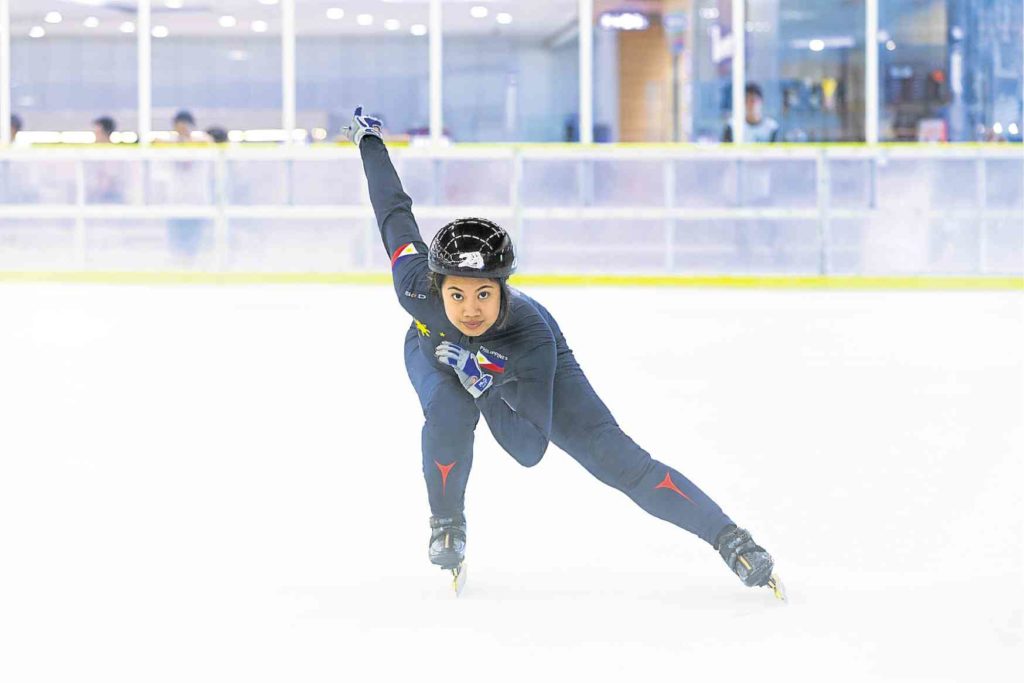Fire, power on ice

Kathryn Magno slices through the ice as she trains at the SM Mall of Asia rink. —Photo courtesy of SM Skating
Trading sparkle for speed hasn’t been the easiest for ice skater Kathryn Magno.
But she’s no longer in the “gray area,” as she calls it. A figure skater since she was five, Magno was so used to coupling her athletic abilities with grace and poise.
Article continues after this advertisementBut in transitioning into a speed skater, Magno needed to summon her old skating skills and pair it this time with power and quickness.
“It was tough in the very beginning but I feel a lot more comfortable now as a speed skater,” says Magno. “I’m not in that gray area of figure and speed. Now, I’m much more comfortable with my body and technique.”
Magno has always known that the glittery sport of figure skating favors the young. But even when the time came to hang up her blades, the itch for ice hardly left her.
Article continues after this advertisement“When I retired from figure skating, I missed the ice,” the Filipino-American shares. “I grew up on the ice, so it was very hard for me to live a normal life, if I can say. I’m used to such gruelling schedule where you train in the morning, train at night. I wanted to go back to figure skating but that didn’t happen.”
Although born and raised in California, Magno has always represented the Philippines in figure skating. It wasn’t long before she found herself shuttling between Manila and California again—but this time, as the first Filipino representative in speed skating (Think of the sport as track running where you race for the best time—but on skates, gliding in an oval ice rink).
“Prior to me switching sports, I was already in my career as a graphic designer, working full time,” says Magno, who traces her roots in Isabela. “I can’t sit in a desk eight hours-plus, so that’s how I transitioned into speed skating.
“But for me, I just wanted to challenge myself,” she adds. “It was supposed to be just recreational. I was 24 when I started, so it wasn’t something that I really wanted to do. I was trying to do it for fun. But an opportunity presented itself, so why not? This is the first time the Philippines will have this sport and I think that’s cool.”
As winter sports debut in the 29th Southeast Asian Games in Kuala Lumpur this month, Magno likes how speed skating, along with ice hockey and figure skating, have grown even in countries with no snow.
“It’s the same goals for them,” Magno says of her fellow trailblazers in Southeast Asian speed skating. “They also want to make history for their country in this sport. And us being a tropical country, we set these goals for each other.”
But the 27-year-old skater knows the region has a lot of catching up to do. At the Asian Winter Games in Sapporo, Japan, last February, Magno failed to advance in the short speed skating event even after a successful campaign in the 2016 Southeast Asia Cup in Singapore where she won gold medals in the 500 meters, 1000m and 1500m.
“Our sport being held for the first time in the SEA Games is already an accomplishment for us,” she says. “Whatever results we get in the SEA Games, we also have to look at it that we made history for the Philippines.”
But Magno, of course, always aims for the win. And she likes her chances in the biennial Games.
“I feel very confident,” says the 5-foot-2 skater. “I think that comes with how I’m training as well. Being on the ice a lot more, being able to see improvements, especially time-wise while I’m training.
“After the Asian Winter Games in Japan, I kind of took a break, reevaluated myself,” she continues. “I went back to the drawing board and figured out what I wanted to do in preparation for the SEA Games. So I honestly think how I’ve been preparing for the SEA Games is a lot more than what I did for the Asian Winter Games. I feel like I’m more in shape.”
Magno thinks it also helps that she’s very familiar with her rivals. “They’re my friends,” she says. “It’s really nice because we all kind of started at the same time in figure skating and trying speed skating.
“We’re competitive with each other, we’re friendly, but we also know how to kind of push each other. For me that helps me because I know how to gauge how we’re going to race—that also comes with the experience of racing each other. Now it’s just a matter of who’s going to break more records.”
The pressure may be all on Magno as the country’s lone representative in speed skating. But the sport’s potentially good future has been enough to keep her going.
“We have up-and-coming speed skaters, but right now I’m The Lone Ranger—that’s what they call me whenever I go to competitions,” she says. “It would be very nice to have teammates with me so that I won’t be the only one on the ice when we carry the flag. In due time it will happen. I’m just paving the way for future speed skaters.”